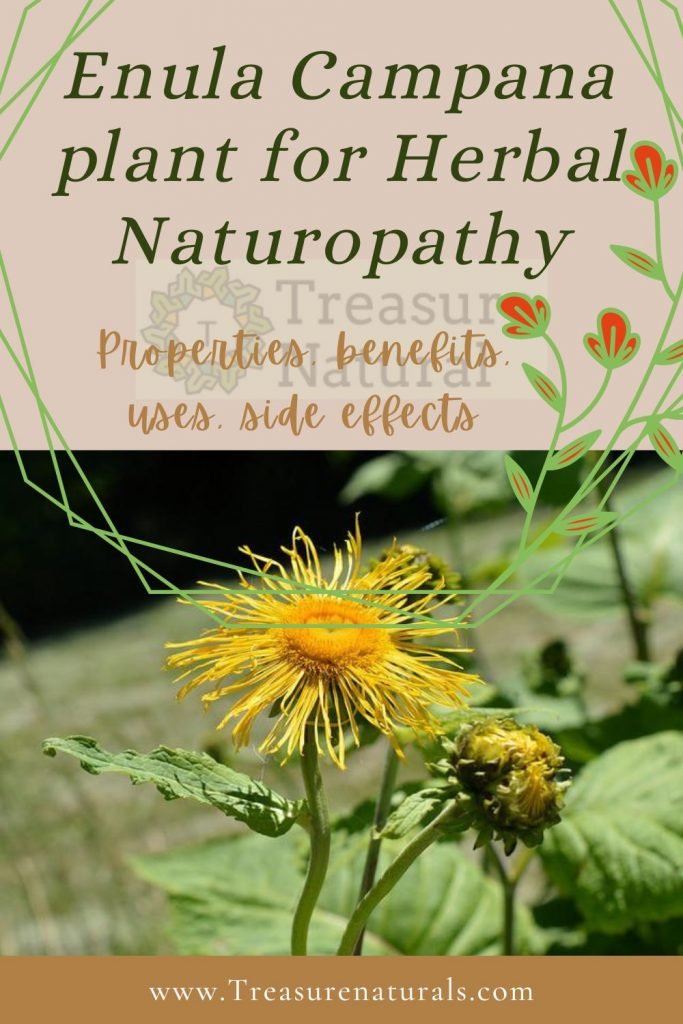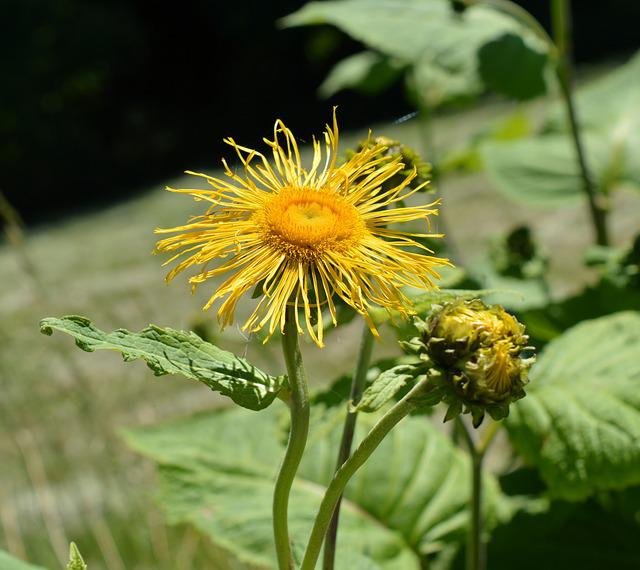
Elecampane (Inula helenium) is a plant of the Asteraceae family (Compositae). Known for its mucolytic and diuretic properties, it is useful against phlegm, gout and rheumatism. Let’s find out better.
Properties of elecampane
The root of elenula (or elenio) contains 1- 3% essential oil (composed of sesquiterpene lactones, alantolactones and sesquiterpene hydrocarbons), sterols (beta-sitosterol, stigmasterol), mucilage, pectins, ascorbic acid and represents one of the most significant amounts of inulin (44%), very important in medicine.
For internal use, the presence of essential oil gives the elecampane an eupeptic action indicated for difficult digestion and lack of appetite; but above all the plant is renowned for the antiseptic, fluidifying and expectorant properties of phlegm, useful for the treatment of respiratory tract disorders, in the presence of cough and cold, acute and chronic bronchitis, asthma and emphysema.
The mixture of alantolactones is called elenine or elenium camphor, and in addition to having anti- inflammatory and antiseptic properties, it has antifungal, anthelmintic and diuretic activities, helping the elimination of urea and chlorides, for this reason the use of elecampane is also indicated against gout and some rheumatic forms.
For external use, decoctions and ointments based on elecampane are remedies for the treatment of itching resulting from eczema, dermatosis, dermatitis, various cold sores and skin rashes in general.
How to use
INTERNAL USE
INFUSION: 1 level spoon of Elecampane root, 1 cup of water
Pour the plant into boiling water and turn off the heat. Cover and leave to infuse for 10 min. Filter the infusion and drink it three times a day, to calm coughs or eliminate uric acids
–Mother tincture of Elecampane: 30 drops three times a day between meals
EXTERNAL USE
DECOCT: 10-30 gr of root in 500ml of water
Pour the chopped root into cold water, turn on the heat and bring to a boil. Boil for a few minutes and turn off the heat. Cover and leave to infuse for 10 min. Apply once it has cooled to calm and soothe itching and skin disorders
Contraindications of elecampane
Enula can produce side effects such as allergic dermatitis, itching, irritation of the mucous membranes, vomiting, diarrhea, cramps. Other possible reactions may be due to ascertained hypersensitivity to one or more components contained in the root.
The use of Enula is not recommended during pregnancy and breastfeeding. Avoid the use of Enula-based products during therapy with diuretic drugs to avoid interaction and side effects.
Description of the plant
Perennial herbaceous plant with large branched fleshy rhizome and very sturdy 100-200 cm high stem. hairy, branched and corymb. The leaves are broad; oblong, toothed, rough above and tomentose on the underside, the lower ones petiolate and the upper sessile.
The flowers have golden-yellow flower heads. The fruits are hairless achenes, devoid of pappus.
The habitat of elecampane
Originally from Central Asia, in Europe it is widespread above all in the southern areas where it was cultivated in the past for medicinal purposes and then spread spontaneously in the Mediterranean basin.
It prefers ruderal places and humid woods, coppices and ditches; but also the hygrophilous meadows and pastures.
Background

The name of the species helenium seems to derive from the Greek name Elena, who according to legend held the plant in her hand when she left for Troy. The currently accepted scientific binomial (Inula helenium).
According to Pliny: “It is said that helenium was born from Helen’s tears and helenium is attributed with cosmetic virtues: it keeps the female skin perfect, both on the face and on the body. They also say that its use gives women beauty and a sensual charm…“Since the plant was somehow connected to the events of Helen of Troy, the great Roman historian and naturalist thought of attributing cosmetic virtues to the plant, even if in reality it has nothing to do with female beauty.
However, the elecampane is cited as an effective remedy in all the authors of Antiquity (from Dioscorides to Albert the Great) and in every Pharmacopoeia for its calming properties of expectorant and diuretic cough.
Used since ancient times for the production of liqueurs, the wine of Enula is famous, used as an aperitif, which is obtained by adding a percentage of dried root to the wine. In Alzazia, the reps is still produced today, a drink that is prepared by macerating the root in the must. In fact, once the root of this plant was used by doctors as a stomachic (facilitates digestive function), vermifuge (eliminates intestinal worms), tonic (strengthens the body in general), diuretic (facilitates the release of urine) and resolutive in general.
It was also used both to dye blue cotton or linen clothes, and as a mordant in dyes with the addition of blackberries.
Today for the large-flowered variety it is also used in gardens to create large patches of color.
At the beginning of the 1900s, inulin, a polysaccharide, with the well-known rebalancing properties of the bacterial flora, was isolated from the phytocomplex of the Enula root, because it was able to increase the density of bifidobacteria and decrease that of harmful bacteria.






